 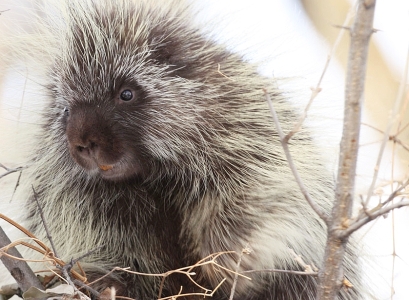 The porcupine, with the scientific name Erethizon dorsatum, is a rodent. It is one of Canada's best-known mammals because of its wide habitat and formidable coat of quills which keeps most enemies at a respectful distance.
The porcupine, with the scientific name Erethizon dorsatum, is a rodent. It is one of Canada's best-known mammals because of its wide habitat and formidable coat of quills which keeps most enemies at a respectful distance.A porcupine has a blunt-nosed face with small eyes and ears. Its shoulders are humped, giving its back an arched look. Its short legs are bowed; the animal has the stance of a bear. The porcupine's claws are long and curved. The muscular tail is thick, short, and rounded at the tip. The porcupine's coat consists of a soft, brown, woolly undercoat and coarse, long guard hairs. The guard hairs conceal the quills until the porcupine is aroused. The quills are longest on the back and tail, and when raised push the guard hairs forward, forming a crest. On the face the quills are about 1.2 cm long; on the back they may be up to 12.5 cm in length. There are no quills on the muzzle, legs, or underparts of the body. 
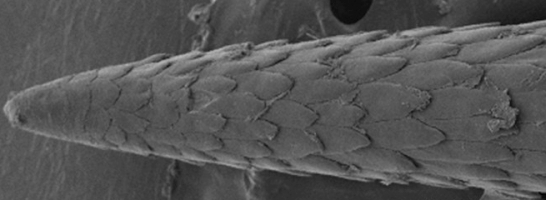 Each quill is hollow and embedded in the skin, where it is attached to a small muscle that pulls it upright in the fur when the animal bristles with alarm. About 0.6 cm from its tip, each quill tapers to a fine point covered by several dozen small black barbs. When the barbs are embedded in flesh they swell, working the quill farther in. The quills have black tips and yellow or white shafts. A porcupines has over 30 000 quills. It will lash its tail threateningly when disturbed, sometimes detaching loose quills; several hundred quills may be dislodged at a time. While a porcupine cannot shoot its quills at a predator, loose quills shaken off will often find their way onto the face of any attacker. As quills are lost they are replaced by new ones, which are white and sharp and which remain firmly anchored in the skin until they are fully grown. 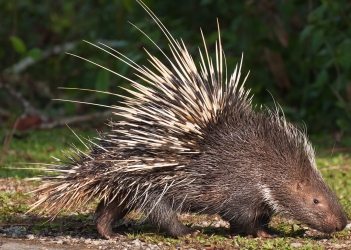 The porcupine is Canada's second largest rodent, next to the beaver. Adult males reach an average weight of 5.5 kg after six years; the females reach 4.5 kg. The total length averages up to a full metre, with a height at the shoulders of about 30 cm.
The porcupine is Canada's second largest rodent, next to the beaver. Adult males reach an average weight of 5.5 kg after six years; the females reach 4.5 kg. The total length averages up to a full metre, with a height at the shoulders of about 30 cm.Solitary for much of the year, and shortsighted and slow moving, porcupines chew on a all sorts of things, including wood, leather, bones, and cast-off antlers, perhaps to satisfy a craving for salt and the need to hone their continuously growing teeth.  During confrontations, a porcupine will chatter its teeth, but they're mostly uncommunicative. The female may control her young with quiet grunts and whines. Only in the mating season are porcupines noisy, emitting a variety of moans, screams, grunts, and barks.
During confrontations, a porcupine will chatter its teeth, but they're mostly uncommunicative. The female may control her young with quiet grunts and whines. Only in the mating season are porcupines noisy, emitting a variety of moans, screams, grunts, and barks.
Mostly porcupines lead solitary lives, although porcupines will group together in winter to share dens or food resources. At these times they usually ignore each other completely. Young porcupines are often playful, and shadowbox using their tails. Sometimes even the normally rather sedate adults are known to play. Porcupines don't hibernate, but they don't move far from their dens in winter, in which they remain if the weather is bad. They also will stay hunched high in a tree until the rain or snow stops. In summer the nocturnal porcupine ranges farther from its den, often searching for food up to 1.5 km away. 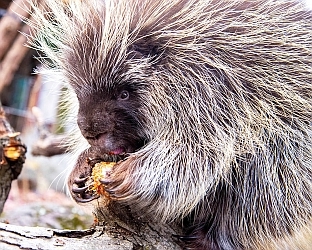 A porcupine eats the inner bark of trees in winter, but it will eat a variety of other plants. It's a slow feeder, relying on its nose to find food. Porcupines apparently have good memories; they are intelligent animals that are capable of learning quickly.
A porcupine eats the inner bark of trees in winter, but it will eat a variety of other plants. It's a slow feeder, relying on its nose to find food. Porcupines apparently have good memories; they are intelligent animals that are capable of learning quickly.Porcupines breed when they are 1 to 2 years old. The male follows the female, attracting her with grunts and humming. When the female is ready to mate, she does a 'dance' with the chosen male, where they both rise on their hind feet to embrace, sometimes placing their paws on each otherís shoulders and rubbing their noses together. The pregnancy lasts about 30 weeks; birth occurs sometime between March and May depending how far north the porcupine is located. The female makes almost no preparations for the birth and does not seek out a nesting den or bed. The solitary baby may be born in a rock pile, under a log stump, or under a brush pile. 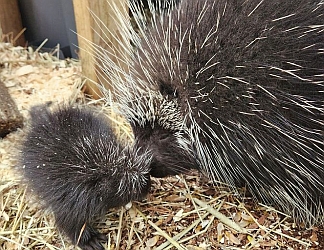 A baby porcupine is well developed at birth. Is eyes are open, and its teeth are exposed. At about 30 cm long, it weighs almost half a kilogram and is covered in thick black hair. The sharp quills are soft and barbless at first, and concealed in the hair. However, within a few hours of birth the quills get hard, and can be raised, and within days the baby can climb trees.
A baby porcupine is well developed at birth. Is eyes are open, and its teeth are exposed. At about 30 cm long, it weighs almost half a kilogram and is covered in thick black hair. The sharp quills are soft and barbless at first, and concealed in the hair. However, within a few hours of birth the quills get hard, and can be raised, and within days the baby can climb trees. After about a week, the mother leaves the baby for longer and longer periods while she feeds on vegetation. By autumn, the young porcupine will be living on its own. 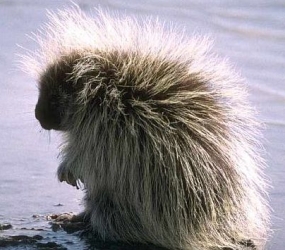 Slow moving porcupines are frequently killed by forest fires and on roads. Surprisingly, they are often injured while climbing trees. Porcupines are also vulnerable to parasites such as ticks and lice, round worms, and tape worms. Slow moving porcupines are frequently killed by forest fires and on roads. Surprisingly, they are often injured while climbing trees. Porcupines are also vulnerable to parasites such as ticks and lice, round worms, and tape worms. Predators of the porcupine include coyotes, cougars, bobcats, red foxes, lynx, bears, wolves, fishers, and Great Horned owls. Some predators learn to avoid the quills and kill the porcupine by biting its head or by flipping the porcupine onto its back to expose the unprotected belly. The fisher a particularly adept porcupine hunter. 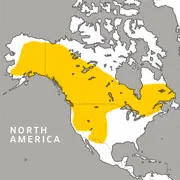  Porcupines can be found all across Canada, as well as in the western U.S. and Alaska. Because of their proximity to people and their pets, encounters are frequent.
Porcupines can be found all across Canada, as well as in the western U.S. and Alaska. Because of their proximity to people and their pets, encounters are frequent. Family pets receiving a face full of quills can usually be saved by a veterinarian, but predators in the wild may become incapacitated, unable to eat, and they may eventually die. 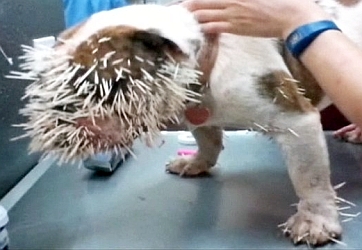
 North American, or 'New World' porcupines, are not the only porcupines in the world. Old World porcupines live in Italy, Asia, and most of Africa. These are large, terrestrial, and strictly nocturnal. The two groups are distinct from one another and are not closely related to each other. The largest species of porcupine is the third-largest living rodent in the world, after the capybara and beaver. |